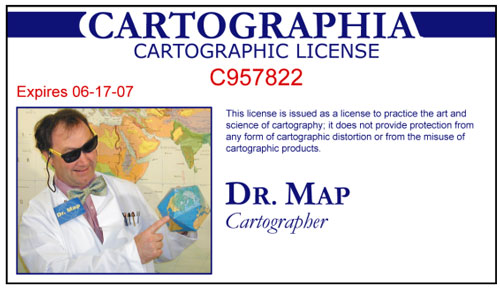Launched just over a year ago, the Ask Dr. Map web site has wowed the world of Cartography. This repository of esoteric map ephemera (also known as “mapcrap” by aficionados) addresses everything from the definition of a “cartophilatelist” to the rumor that Waldo Tobler used to receive mail addressed to the latitude and longitude of his home. To quote its home page, “this web site contains answers to questions about maps submitted to Dr. Map, the “anonymous” author of the column “Ask Dr. Map,” printed bi-monthly in the ACSM Bulletin, journal and newsletter of the American Congress on Surveying and Mapping. This site contains material that is copyrighted, but with the author’s permission this material can be used in other publications. For questions and queries, send e-mail to askdrmap@cox.net (editor’s note: this is the correct email address). Dr. Map has a Ph.D. and a cartographic license, and is not afraid to use the latter!”
Sample Q & A:
Dear Dr. Map, Do cartographers ever make deliberate errors on maps?
According to the article in the London Times (3/6/01), the British Ordnance Survey (or OS, the Government mapping agency in the U.K.) has deliberately made errors in its maps in order to be able to detect copyright violations. This was revealed when the British Automobile Association agreed to pay 20 million pounds ($32M) in an out-of-court settlement, after it was caught plagiarizing Ordnance Survey maps. The cartographers had added deliberate faults, such as tiny twists in rivers, exaggerated curves in roads, missing apostrophes in place names, and non-existent buildings, in dozens of their maps to trap people who were copyrighting them–a simple task when done digitally. Over 500 publications were involved, accounting for some 300 million paper maps. The OS would not give examples of its secret system, contending that the changes were not errors but “subtle and secret ways of detecting plagiarizing, rather like watermarks.”
Dr. Map notes that this is probably common practice worldwide. In the United States, however, not only are facts about the surface of the earth not subject to copyright, but the USGS makes maps available in the public domain. So that copying directly is a legal activity. Makes one wonder what might happen if your car drove into a real British river while taking an imaginary steep curve using its in-vehicle navigation system and one of the AA maps.
Article by Bill Norrington


